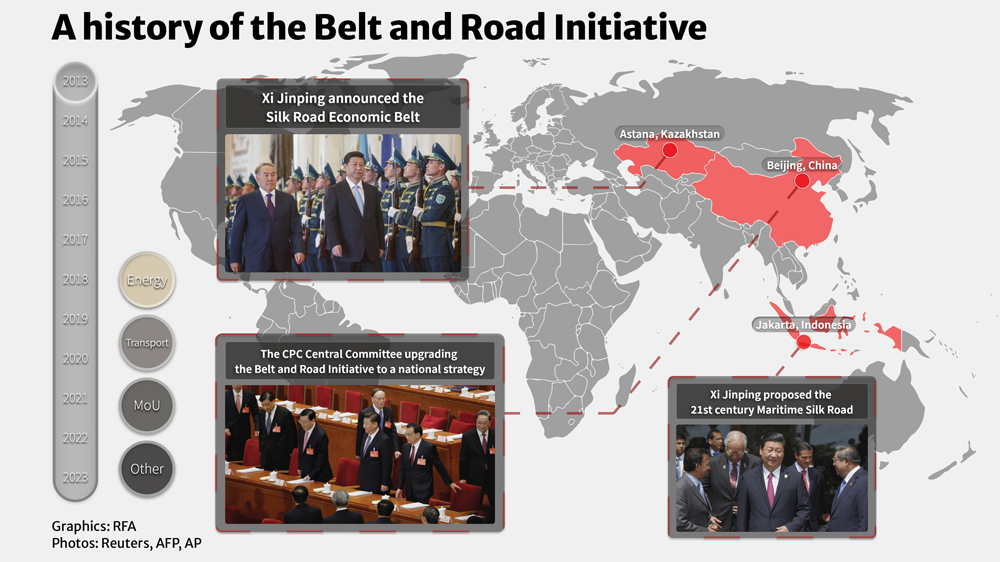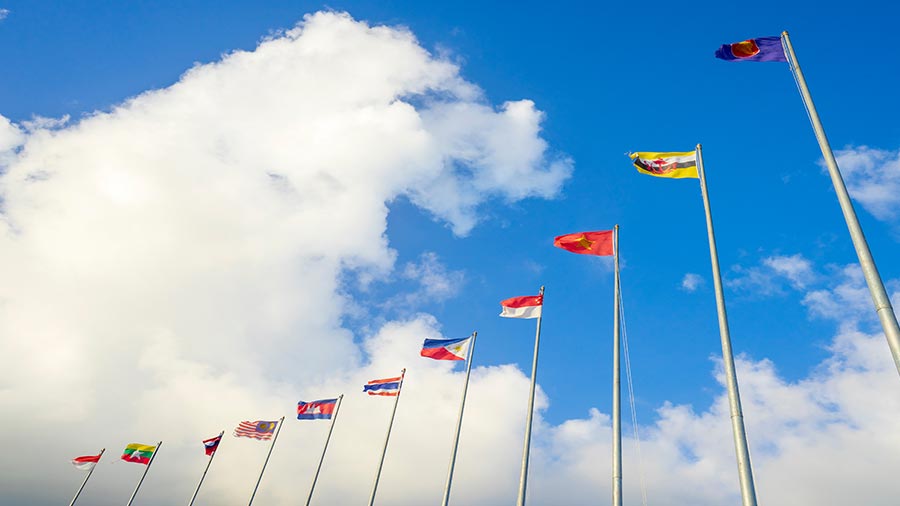China
10 years on, Belt and Road goals shift with China’s ambitions

A decade ago, amid much fanfare, Chinese President Xi Jinping launched the Belt and Road program, a grand plan to build a global infrastructure and supply chains that would connect China to the rest of the world in a modern and many-pronged Silk Road – and hypothetically benefit everyone involved.
Next month, Beijing will host the third Belt and Road Forum for International Cooperation, with confirmed attendance from a number of world leaders and representatives from 90 countries, state news agency Xinhua reported.
What started out as a way to boost trade ties, secure energy supplies and invest in global infrastructure has now branched out to include digital, health, cultural, security, and sustainable development projects, some of which have been dogged by labor issues and cost overruns.
Playing off the motif of the ancient trade route that linked China to the Mideast and Europe, Its components are many, and include the Digital Silk Road, the Silk Road on Ice, the Healthy Silk Road, the Space Silk Road, and the Green Silk Road.
In fact, today almost all of China’s overseas cooperation projects could be classified as part of the Belt and Road Initiative. Xi has termed it the “project of the century.”
Critics of how China uses its rising power are less sanguine. The United States has accused China of “debt diplomacy” – trapping nations with financial liabilities for major infrastructure projects they can ill-afford and which might be leveraged for Beijing’s political benefit.
$1 Trillion in investment
The forum comes four years after the last Belt and Road summit in 2019, and is part of China’s bid to show off the program’s achievements to the international community after a decade in operation.

The program has sparked some US$1 trillion of investments, foreign ministry spokesman Wang Wenbin told a recent news conference. Around 83% of China’s diplomatic allies and nearly 80% of the 193 UN member states have gotten involved.
Over the past decade, China has signed more than 200 cooperation agreements with 152 countries and 32 international organizations under the plan.
China now spends twice as much on international development finance as the United States, according to the U.S.-based organization AidData, with most of that increase occurring during the past 10 years.
There has been a political benefit as well: Some of those deals have led partner countries to publicly support Chinese Communist Party propaganda on Xinjiang, where China has persecuted 11 million Uyghurs and other Turkic minorities and sought to erase their culture.
What’s the goal?
Researchers have been collating vast amounts of data and official sources to try to answer questions about the purpose of the Belt and Road — does it fulfill China’s economic, diplomatic or strategic ambitions?
The answer is all of the above.

It facilitates the offshoring of China’s production capacity, offers a powerful tool for the country’s diplomats and is also a key plank in Beijing’s geostrategic framework.
It expands China’s global influence and promotes Xi Jinping’s ultimate vision of creating a China-centered global order.
And with the decoupling of China’s flagging economy from that of the United States, and China’s exclusion from key technology supply chains, China appears to need the Belt and Road Initiative more than ever.
Radio Free Asia is marking the 10th anniversary of the Belt and Road with a series of features about how the plan has evolved over the past decade, and its impact on the countries and people it touches.
For example, China has been dialing back investment in overseas infrastructure projects, while boosting it in the digital sector.
The country’s homegrown global navigation satellite system Beidou now spans 165 capital cities around the world, providing broader coverage than GPS created by the United States.
Huawei, which has been widely boycotted by governments in Europe and the United States, built 70% of the 4G networks currently in operation in Africa.
Exporting surveillance platforms
Meanwhile, China has continued to export surveillance platforms for policing and domestic security to at least 80 countries around the world.
The technology sector has become a hotly contested battleground in China’s global strategic plan, which includes exporting its brand of digital authoritarianism, while competing for a share of future markets.

Globally, 2.9 billion people still lack access to the internet, and China has set its sights on the digital divide, hoping to gain the support of more countries by gaining a foothold in emerging markets, where it can position itself as the digital standard-setter.
Indonesia – the fourth most populous nation on the planet – is one of those markets. Nearly half of its 270 million people are under the age of 30, making it uncharted territory for the digital economy.
Yet Chinese telecoms giant Huawei is already charting that territory, offering cheaply built infrastructure, personnel training and government publicity services.
Radio Free Asia has been examining some of the concerns and potential threats posed by China’s monopolistic practices in the region.
China’s digital presence can also be felt across a number of large-scale regional infrastructure projects.
The China-Laos high-speed railway doesn’t just run on Chinese-gauge tracks with Chinese-made locomotives and rolling stock: it also uses Chinese technology in its ID-card verification system and security checkpoints.
Resistance
Some countries and leaders have tried to resist the “China model,” including former Micronesian President David Panuelo.
In an open letter published two months before he left office in May 2023, Panuelo said China had used a combination of…
Read the rest of this article here >>> 10 years on, Belt and Road goals shift with China’s ambitions
Business
Gordonstoun Severs Connections with Business Led by Individual Accused of Espionage for China

Gordonstoun school severed ties with Hampton Group over espionage allegations against chairman Yang Tengbo. He denies involvement and claims to be a victim of political tensions between the UK and China.
Allegations Lead to School’s Decision
Gordonstoun School in Moray has cut ties with Hampton Group International after serious allegations surfaced regarding its chairman, Yang Tengbo, who is accused of being a spy for the Chinese government. Known by the alias "H6," Mr. Tengbo was involved in a deal that aimed to establish five new schools in China affiliated with Gordonstoun. However, the recent allegations compelled the school to terminate their agreement.
Public Denial and Legal Action
In response to the spying claims, Mr. Tengbo publicly revealed his identity, asserting that he has committed no wrongdoing. A close associate of Prince Andrew and a former Gordonstoun student himself, Mr. Tengbo has strenuously denied the accusations, stating that he is a target of the escalating tensions between the UK and China. He has claimed that his mistreatment is politically motivated.
Immigration Challenges and Legal Responses
Yang Tengbo, also known as Chris Yang, has faced additional challenges regarding his immigration status in the UK. After losing an appeal against a ban enacted last year, he reiterated his innocence, condemning media speculation while emphasizing his commitment to clear his name. Gordonstoun, on its part, stated its inability to divulge further details due to legal constraints.
Source : Gordonstoun cuts ties with business chaired by man accused of spying for China
Business
China Dismantles Prominent Uyghur Business Landmark in Xinjiang – Shia Waves

The Chinese government demolished the Rebiya Kadeer Trade Center in Xinjiang, affecting Uyghur culture and commerce, prompting criticism from activists amid concerns over cultural erasure and human rights violations.
Demolition of a Cultural Landmark
The Chinese government recently demolished the Rebiya Kadeer Trade Center in Urumqi, Xinjiang, a vital hub for Uyghur culture and commerce, as reported by VOA. This center, once inhabited by more than 800 predominantly Uyghur-owned businesses, has been deserted since 2009. Authorities forcibly ordered local business owners to vacate the premises before proceeding with the demolition, which took place without any public notice.
Condemnation from Activists
Uyghur rights activists have condemned this demolition, perceiving it as part of China’s broader strategy to undermine Uyghur identity and heritage. The event has sparked heightened international concern regarding China’s policies in Xinjiang, which have been characterized by allegations of mass detentions and cultural suppression, prompting claims of crimes against humanity.
Rebiya Kadeer’s Response
Rebiya Kadeer, the center’s namesake and a notable Uyghur rights advocate, criticized the demolition as a deliberate attempt to erase her legacy. Kadeer, who has been living in exile in the U.S. since her release from imprisonment in 2005, continues to advocate for Uyghur rights. She has expressed that her family members have suffered persecution due to her activism, while the Chinese government has yet to comment on the legal ramifications of the demolition.
Source : China Demolishes Uyghur Business Landmark in Xinjiang – Shia Waves
China
China Expands Nationwide Private Pension Scheme After Two-Year Pilot Program

China’s private pension scheme, previously piloted in 36 cities, will roll out nationwide on December 15, 2024, enabling workers to open tax-deferred accounts. The initiative aims to enhance retirement savings, address aging population challenges, and stimulate financial sector growth.
After a two-year pilot program, China has officially expanded its private pension scheme nationwide. Starting December 15, 2024, workers covered by urban employee basic pension insurance or urban-rural resident basic pension insurance across the country can participate in this supplementary pension scheme. This nationwide rollout represents a significant milestone in China’s efforts to build a comprehensive pension system, addressing the challenges of a rapidly aging population.
On December 12, 2024, the Ministry of Human Resources and Social Security, together with four other departments including the Ministry of Finance, the State Taxation Administration, the Financial Regulatory Administration, and the China Securities Regulatory Commission, announced the nationwide implementation of China’s private pension scheme effective December 15, 2024. The initiative extends eligibility to all workers enrolled in urban employee basic pension insurance or urban-rural resident basic pension insurance.
A notable development is the expansion of tax incentives for private pensions, previously limited to pilot cities, to a national scale. Participants can now enjoy these benefits across China, with government agencies collaborating to ensure seamless implementation and to encourage broad participation through these enhanced incentives.
China first introduced its private pension scheme in November 2022 as a pilot program covering 36 cities and regions, including major hubs like Beijing, Shanghai, Guangzhou, Xi’an, and Chengdu. Under the program, individuals were allowed to open tax-deferred private pension accounts, contributing up to RMB 12,000 (approximately $1,654) annually to invest in a range of retirement products such as bank deposits, mutual funds, commercial pension insurance, and wealth management products.
Read more about China’s private pension pilot program launched two years ago: China Officially Launches New Private Pension Scheme – Who Can Take Part?
The nationwide implementation underscores the Chinese government’s commitment to addressing demographic challenges and promoting economic resilience. By providing tax advantages and expanding access, the scheme aims to incentivize long-term savings and foster greater participation in personal retirement planning.
The reform is expected to catalyze growth in China’s financial and insurance sectors while offering individuals a reliable mechanism to enhance their retirement security.
| This article was first published by China Briefing , which is produced by Dezan Shira & Associates. The firm assists foreign investors throughout Asia from offices across the world, including in in China, Hong Kong, Vietnam, Singapore, and India . Readers may write to info@dezshira.com for more support. |
Read the rest of the original article.







